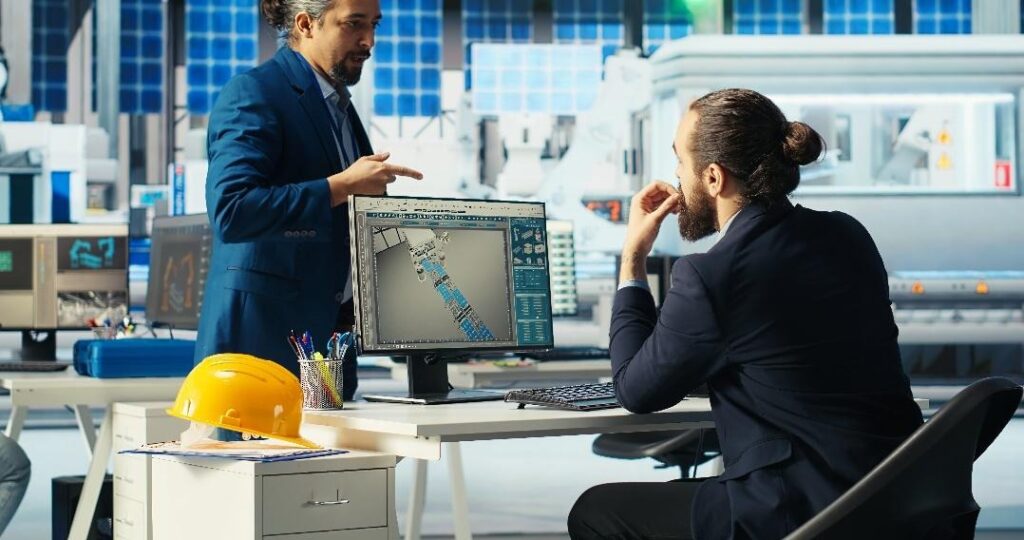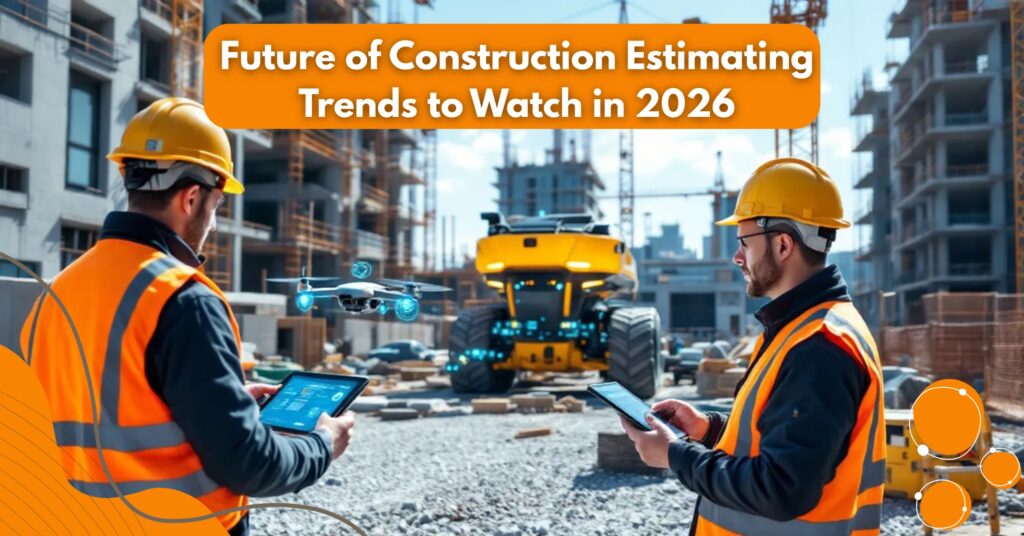It happens, you’re knee-deep in a big project bid. Spreadsheets stretch across your desk like a tangled web. Hours slip by as you crunch numbers for materials and labor. Then a curveball hits rising steel prices or a surprise permit fee, and your whole estimate crumbles. If you’ve ever lost a project because your numbers didn’t work or profits vanished on overruns, you’re not alone. Construction pros face this grind daily. However, here’s a shift in this trend. By 2026, smart shifts in how we estimate costs will turn that headache into a smooth ride. We’ll dive into rising tech, like AI and automation, that speed up things and cut errors. Moreover, we’ll cover green buildings that save money long-term. You’ll see how these changes can sharpen your edge for accurate cost forecasting in commercial builds or affordable roofing estimates for contractors.
Emerging Technologies Reshaping the Estimating Game
Construction estimating isn’t just about adding up costs anymore. It is evolving with advanced tools that use data from everywhere and perform predictions. It is just like a turbo boost to your intellect. In 2026, expect these game-changers to lead the pack. Some of them are as follows.
AI and Machine Learning: Your New Estimating Boost
AI is not some kind of sci-fi dream. It’s here now, and getting sharper and sharper. Machine learning, which is a branch of AI, performs historical search from past projects to predict future costs with great accuracy. For instance, it scans blueprints and spots patterns humans might miss, like how weather tweaks timelines in outdoor work. One of the Florida firms that switched to AI-driven software boosted estimate accuracy by 20% and reduced prep time by 40%. No more late nights double-checking takeoffs. Instead, estimators focus on big-picture strategy, like tweaking bids for tight deadlines.
What does this mean for you? If you are handling residential remodel projects, AI can forecast material needs based on local supply chains. Tools like these handle the grunt work, freeing you to chase leads. And for larger outfits bidding on highways or offices, predictive analytics flags risks early, like supply shortages that could hike costs 15 percent.
Automation: Streamlining the Projects
Manual calculations are now an old era. In this tech era, automation software links estimating apps to accounting systems, updating real-time prices. Cloud-based platforms let teams collaborate from job sites, with no VPN hassles.
Picture a crew estimating a warehouse build. Automation pulls live data on lumber prices and labor rates, adjusting bids on the fly. Reports show this cuts turnaround by 80 percent. For small contractors juggling multiple jobs, that’s huge. It means more bids out the door and fewer lost to slower rivals. If you’re searching for “trends in estimating software for small teams,” these tools fit the bill. They’re affordable and scale with your growth, turning solo hustles into steady streams.

BIM and Digital Twins
Building Information Modelling (BIM) creates 3D digital versions of projects. Add digital twins that are virtual replicas that update live, and you’ve got crystal clear costs. These techs simulate builds, spotting clashes that add 10-20 percent to budgets if caught late.
How AI, Machine Learning, and Automation Team Up for Smarter Processes
These aren’t standalone gadgets. They weave together for a powerhouse workflow. Start with AI scanning docs for quantities. Machine learning then layers in historical data to predict variances, like how inflation hits concrete pours. Automation seals it by generating reports with one click.
Benefits stack quickly. Accuracy jumps, reducing underbids that bleed cash, think 5-10 percent of project value gone in a flash. Speed lets you bid on more jobs, padding your pipeline. And error rates? Down by half, per industry stats.
For challenges like volatile markets, these tools shine. They integrate weather APIs for site-specific tweaks or track supplier trends for precise quotes. If you’re tired of estimates that flop under scrutiny, this combo delivers bids clients trust and sign.
Sustainability Trends Impact on Construction Estimates
Sustainability isn’t a buzzword. It’s a bid-winner. Clients demand eco-friendly builds, and estimators must price them right. By 2026, green practices will shape 40 percent of projects, per forecasts.
Lifecycle Costing: Beyond the Sticker Price
Traditional estimates stop at build day. But smart ones factor full lifecycles, energy bills, maintenance, and even resale value. Green roofs or solar panels might add 2-7 percent upfront, but cut costs 20-30 percent over time. For sustainable construction cost forecasting seekers, here’s the gold means recycled steel cuts material fees by 15 percent while meeting LEED standards. Estimators who highlight these ROI hooks win loyal clients.
Material Shifts and Waste Reduction
Expect low-carbon concrete and bio-based insulators to norm up. Automation optimizes cuts to trim waste by 30 percent. This lowers disposal fees and appeals to eco-conscious owners. These trends demand new skills. Miss them, and your estimates look outdated. Nail them, and you stand out in a crowded field.

Why Keeping Pace with Trends Spells Success for Your Bids
Inaccurate estimates aren’t just annoying. They’re killers. Overruns wipe 12% of profits yearly. Underbids mean cheap work or lost jobs. Staying current flips that script.
- Inaccurate estimates kill profits:
Overruns erase 12% of your yearly earnings. Underbids lock you into low-margin work or cost you the entire project. One bad number can sink an entire quarter.
- Staying current flips the script:
Modern tools replace guesswork with data-driven precision. You move from reactive fixes to proactive wins. Competitors still crunching spreadsheets get left behind.
- Builds instant client trust:
Clients spot forward-thinking bids that avoid hidden risks. They choose reliability over the lowest and riskiest price. Trust turns one-off jobs into repeat partnerships.
- Saves time:
Automation cuts estimate prep from days to hours. You stay sharp without drowning in emerging construction technologies. More time means more bids and faster decisions.
- Opens premium project doors:
Green expertise on net-zero offices commands 10% higher fees. Clients pay extra for estimators who speak sustainability fluently. These high-value gigs become your new normal.
- Hesitate, and competitors pass you:
Delay adoption, and rivals lock in the best contracts. Embrace trends and you set the pace others chase. Momentum builds the moment you act.
ALM Estimating: Gear Up for Tomorrow’s Challenges Today
At ALM Estimating, we’re not waiting for 2026. We’re building it now. Our team dives deep into AI integrations and sustainable modelling to craft bids that win and deliver. We’ve helped firms like yours cut errors by 25% while hitting green targets. Ready to join them? Our experts tailor solutions for everything from quick residential quotes to complex commercial forecasts. No generic tools, just precision that scales with your business. Moreover, ALM Estimating has more than 20 years of experience, and they have evolved along with the modern trends. We started with pencil and paper. We grew through spreadsheets and CAD. Now, we lead with AI-powered accuracy and real-time data. That depth means we understand your daily grind, tight deadlines, rising costs, demanding clients, and we solve it with tools that work today, not someday. Our slogan is “Accuracy Built In. Profits Locked In.” Let us prove it on your next bid.

Wrapping It Up: Your Move to a Stronger Future
The future of construction estimating brims with promise. AI sharpens precision. Automation frees your focus. Sustainability secures long hauls. Ignore these, and you risk fading out. Grab them, and you’ll lead the pack with bids that impress and endure. For coping with the future trends, you have to partner with pros like ALM Estimating, who are the masters of automation. The modern techniques not only give you the accuracy but also the confidence to bid competitively.
Tired of tech overwhelm? With ALM Estimating, experts map your 2026 roadmap and out-compete your competitors. Get a 30% discount on your first estimate. Contact us now!
FAQs:
Q1. What role does AI play in future construction estimating?
AI automates takeoffs and predicts costs using past data. It boosts accuracy by 20 percent and speeds bids, helping estimators spot risks like material hikes early. This lets you focus on strategy over spreadsheets.
Q2. How will machine learning change cost forecasting?
Machine learning analyzes trends to forecast prices with 80 percent less error. For example, it adjusts for regional labor shifts, making your “construction cost forecasting for urban projects” more reliable and competitive.
Q3. Are automation tools worth the switch for small contractors?
Absolutely. They link estimating to real-time data, cutting prep time in half. Affordable options exist for teams under 10, turning solo bids into team efforts without big upfront costs.
Q4. What sustainability practices impact estimates most in 2026?
Lifecycle costing tops the list, factoring in energy savings from green materials. Upfront premiums of 2-7 percent yield 20-30 percent ops cuts, a must for “affordable green roofing estimates for contractors.”
Q5. How do digital twins help with accurate bids?
Digital twins simulate projects to catch issues pre-build, reducing change orders by 25 percent. They’re key for complex jobs like hospitals, ensuring estimates match real outcomes.
Q6. Can I integrate BIM with existing estimating software?
Yes, most modern tools plug in seamlessly. Start small with 3D modeling add-ons to refine quantities, then scale to full workflows for better “trends in estimating software” adoption.
Q7. What pain points do these trends solve for estimators?
They tackle overruns from manual errors and market volatility. Pros report 40 percent faster bids, easing the crunch of juggling multiple “future construction technologies” learning curves.
Q8. How much do green builds really cost extra?
Typically, 2-7 percent more initially, but ROI hits quickly via savings. Tools now model this to show clients the full picture, winning more eco-focused contracts.
Q9. What’s one quick win from adopting AI in estimating?
Real-time price updates via cloud links. It prevents underbids on fluctuating items like steel, a game-changer for “construction estimating innovations” in volatile markets.
Q10. How do I stay updated on these trends without overload?
Follow industry reports and join webinars. Partner with experts like those at ALM for tailored insights, and keep you sharp on “AI in construction” without the solo slog.
